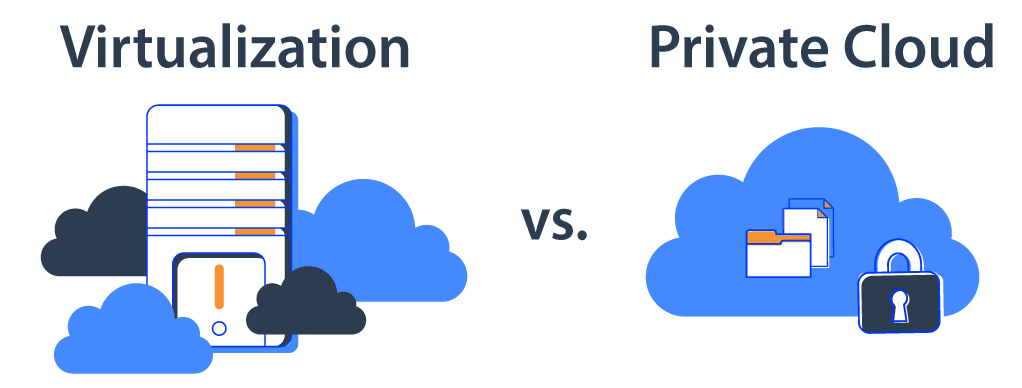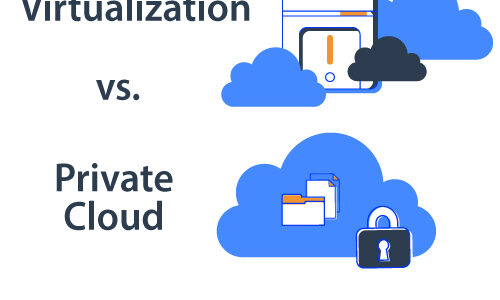Private Cloud vs. Virtualization
Distinguishing the differences between private cloud and virtualization can leave even IT pros confused. “Are they the same? Or different? In what way and how? We have already virtualized most of our computing resources, is a private cloud still relevant to us?” These are questions that are been frequently asked.
Before getting the answers, let’s set a baseline in the first article of the two-part series listed below.
Real Life Examples of Virtualization
Lately, many IT shops have introduced virtualization into existing computing environments. Consolidating servers, mimicking production environment, virtualizing test networks, monitoring networks with honey pots, and adding disaster recovery options. are just a few applications of employing virtualization. Some also run highly virtualized IT with automation provided by system management solutions. Many IT pros recognize the benefits of virtualization, such as including more efficient utilization of servers and associated savings by reducing physical footprint.
Virtualization in a Cloud Centric Era
Now that we have moved into a cloud centric era, the question becomes “Is virtualization the same with a private cloud?” or “We are already running a highly virtualized environment, do we still need a private cloud?“ The answers to these questions should always start with, “What business problems are you trying to address?” From there, you can assess if a private cloud solution can fundamentally solve the problem, or if virtualization is sufficient. This is of course assuming there is a clear understanding of the components of virtualization and a private cloud.
Virtualization and cloud computing are not the same. They address IT challenges in different dimensions and operate in different scopes with different levels of impact on a business.

Virtualization
To make a long story short, virtualization in the context of IT is to “isolate” computing resources such that an object (i.e. an application, a task, a component) in a layer above can be possibly operated without a concern of those changes made in the layers below.
The terms, virtualization, and “isolation” are chosen for specific reasons since there are technical discrepancies between “virtualization” and “emulation”, along with “isolation” and “redirection.” Virtualization isolates computing resources, offering an opportunity to relocate and consolidate isolated resources for better utilization and higher efficiency. Virtualization is rooted in infrastructure management, operations, and deployment flexibility. It’s about consolidating servers, moving workloads, streaming desktops, and so on; which without virtualization are not technically feasible or may simply be cost-prohibitive.
Cloud Computing
Cloud computing, on the other hand, is a state, a concept, and a set of capabilities. There are statements made on what to expect in general from cloud computing. A definition of cloud computing published in NIST SP-800-145 outlines the essential characteristics, how to deliver, and what kind of deployment models to be cloud-qualified. Chou further simplifies cloud computing with the 5-3-2 Principle as illustrated below.
Unequivocally Different
To realize the fundamental differences between virtualization and private cloud is therefore rather straightforward. In essence, cloud computing is based on the 5-3-2 Principle, whereas virtualization is not. For instance, a self-serving model is not an essential component in virtualization, while it is essential in cloud computing. One can certainly argue some virtualization solution may include a self-serving component. The point is that self-service is not a necessary, nor sufficient condition for virtualization. While in cloud computing, self-service is a crucial concept to deliver anytime availability to user, which is what a service is all about. Furthermore, self-service is an effective mechanism to reduce training and support in the long run at all levels. It is a crucial vehicle to accelerate the ROI of a cloud computing solution and make it sustainable in the long run.
You might also like
- QuickBooks in the Cloud: The Sky’s the Limit
- Database Cloud Services in Orange County: Scale at Will
- Distinguishing Between Public, Hybrid, & Private Cloud Solutions
- Quickbooks Cloud Hosting: How to Lower your IT Budget
- How Secure Cloud Technology Mitigates DDoS Attacks
- Suggested Responses to Recent AWS Cloud Outages from Industry Experts
- Creating Cloud Solutions That Benefit Your Company and Streamline Your Work Process
- What is a Cloud Client?
- Private Cloud as a Service
- What is a Community Cloud?
- Infrastructure as a Services (Iaas)
- Platform as a Service (PaaS)


